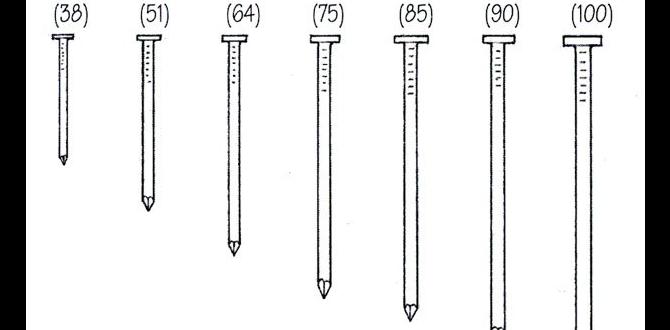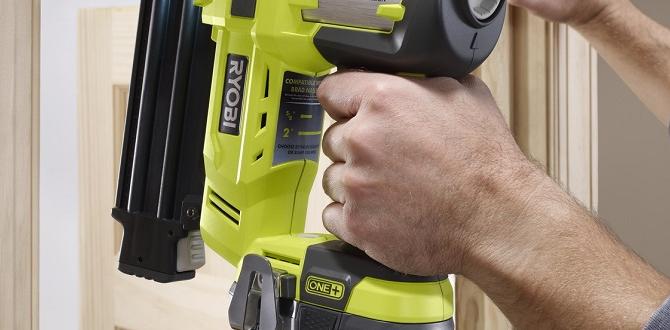Have you ever wondered how carpenters choose nails for their projects? Sizing nails for woodworking frames is a key step in building strong structures. Imagine trying to build a treehouse with the wrong nails. Wouldn’t that be frustrating? It could even be dangerous!
Nails come in different sizes, and each serves a purpose. Choosing the right size helps your frame hold together nicely. A nail that’s too short might not grip well, while one that’s too long can split the wood. This simple choice makes a big difference in your project’s success.
Did you know that most carpenters have a special trick for sizing nails? They often match the nail length to the thickness of the wood. This guide will help you understand how to size nails properly for your woodworking needs. Let’s dive into the world of woodworking and discover the secrets of nails!
Table of Contents
Sizing Nails For Woodworking Frame: A Complete Guide

Sizing Nails for Woodworking Frames
Choosing the right nails for woodworking frames is crucial. The size of the nail affects strength and stability. A good rule is to pick nails that are at least twice as long as the thickness of the wood. This ensures a strong hold. Always consider wood type too; softwoods need different nails than hardwoods. Did you know that using the wrong size can lead to weak frames that fall apart? It’s essential to measure carefully before you start!Factors to Consider When Sizing Nails
Importance of wood thickness and nail length. Loadbearing factors and how they impact nail selection.Choosing the right nails for woodworking is like picking the perfect slice of pizza. Too short, and it flops; too long, and you may poke your neighbor! Think about how thick your wood is. Thinner wood needs shorter nails while thicker wood requires longer ones. How much weight will your frame hold? Heavier loads call for stronger, thicker nails. Let’s keep our creations standing tall and not wobbly like a giraffe on roller skates!
| Wood Thickness | Nail Length | Load-Bearing Factor |
|---|---|---|
| 1/2 inch | 1.25 inches | Light loads |
| 3/4 inch | 1.5 inches | Moderate loads |
| 1 inch | 2 inches | Heavy loads |
Recommended Nail Sizes for Different Wood Projects
Common nail sizes for framing vs. finishing. Examples of specific projects and their corresponding nail sizes.Choosing the right nail size is as important as finding the right pair of shoes. Go too small, and your project might fall apart. Go too big, and you might end up with a splinter disaster! For framing projects, a common choice is 16-gauge nails, while finishing tasks often call for 18-gauge nails.
| Project Type | Recommended Nail Size |
|---|---|
| Framing a Wall | 16-gauge |
| Attaching Trim | 18-gauge |
| Building Furniture | 16 or 18-gauge |
| Cabinet Assembly | 18-gauge |
So remember, use the right nails to keep your projects from falling down—literally! And always keep your fingers away from where they shouldn’t be—nails have a funny way of claiming them!
Techniques for Proper Nail Selection
Guidelines on how to choose the right nail based on wood type. Tips for using nail size charts effectively.Choosing the right nail for your woodworking project can feel like picking a favorite ice cream flavor—lots of choices! Different woods need different nails. For softwoods like pine, use thinner nails. Hardwoods, like oak, need stronger nails. Check out a nail size chart for quick help. It tells you what size works best. Trust me, no one likes a popped-out nail at a party!
| Wood Type | Recommended Nail Size |
|---|---|
| Softwood (Pine, Cedar) | 6d to 8d |
| Hardwood (Oak, Maple) | 10d to 12d |
Follow these guidelines, and your frame will be stronger than your neighbor’s dog behind a fence. Happy nailing!
Common Mistakes in Nail Sizing
Errors to avoid when selecting nails for woodworking frames. Consequences of using improperly sized nails.One big mistake is choosing nails that are too short. They can’t hold weight. This can cause your frame to fall apart. Another error is using nails that are too long. They might poke through the other side, making it look messy. Using the wrong size nails can lead to weak structures. In woodworking, strength is key. Avoid these mistakes for a strong and safe frame.
What happens if you use the wrong nails?
Using improperly sized nails can weaken your woodworking. It can lead to breaks, twists, or even total failure. This means your project might fall short of looking good or lasting long.
- Too short: weak hold
- Too long: visible damage
- Wrong type: poor grip
Tools and Accessories for Nail Installation
Essential tools for driving nails (e.g., hammers, nail guns). Accessories that assist in proper nail application and alignment.To install nails, you need the right tools. Hammers are classic choices. They are simple but effective. Nail guns are great for speed. They shoot nails quickly, making tasks easier. Accessories help too! They ensure nails go in straight. Some helpful accessories include:
- Clamps for holding materials still
- Jigs for perfect nail placement
- Guides to keep nails aligned
With these tools, you can work faster and smarter!
What are essential tools for driving nails?
Nail guns and hammers are essential for driving nails. They help you work quickly and efficiently.
Best Practices for Nail Placement in Woodworking Frames
Strategies for spacing and angling nails for optimal strength. How to avoid splitting wood during nail installation.Placing nails correctly in woodworking frames is key for strength. Start by spacing nails evenly, about 6 to 8 inches apart. This way, the wood won’t bend or break. Next, angle the nails slightly. This adds extra support. To avoid splitting, pre-drill small holes where you plan to nail. This helps the wood stay intact.
How can I stop wood from splitting when I nail?
Pre-drilling holes is the best way. Also, use shorter nails for thin wood pieces. Keeping the nails away from the edges helps, too. Remember, patience pays off!
Case Studies: Real-World Applications of Nail Sizing
Examples of successful woodworking projects with appropriate nail sizing. Lessons learned from case studies to inform future nail choices.In the world of woodworking, the right nail size can make all the difference. One project involved building a sturdy picnic table. Using 3-inch nails ensured the frame held strong during family feasts. Another case featured a cozy birdhouse, where 1.5-inch nails were perfect for delicate details. These examples show that choosing the correct nail matters. A little extra time picking the right size saves future headaches, like sagging tables or wandering birds!
| Project | Nail Size Used | Outcome |
|---|---|---|
| Picnic Table | 3-inch | Very sturdy; holds up well |
| Birdhouse | 1.5-inch | Adorable and sturdy |
Conclusion
In summary, sizing nails for woodworking frames is important for strong projects. Use longer nails for heavy frames and shorter ones for light work. Choose the right material too—steel is great for most tasks. Now that you know these tips, try them in your next project! For more guidance, explore books or online resources about woodworking.FAQs
What Are The Best Types Of Nails To Use For Different Woodworking Frame Sizes And Applications?For small frames, you can use brad nails because they’re thin and won’t split the wood. For bigger frames, finish nails are better since they’re stronger. If you’re building something heavy, like a big chair, use special nails called screws. They’re really strong and hold things tighter. Always pick the right nail for your project to make it safe and sturdy!
How Do I Determine The Appropriate Length Of Nails Needed For Framing Joints In Woodworking?To choose the right nail length for framing, first, check the thickness of the wood pieces you are joining. You want your nails to go through both pieces and stick out a bit. A good rule is to use nails that are at least twice the thickness of the thinner piece. So if one piece is 1 inch thick, use nails that are 2 inches long. This ensures a strong hold!
What Nail Gauge Should I Choose For Optimal Strength And Durability In Wooden Frame Constructions?For strong wooden frames, choose 16-gauge nails. They are thick enough to hold things together well. Use them for important parts like beams. They help make your structure last longer.
How Does The Type Of Wood Being Used Affect The Nail Sizing And Selection For Woodworking Frames?The type of wood you use can change the size of nails you need. Soft woods, like pine, need smaller nails because they are easier to push in. Hard woods, like oak, need bigger nails for a strong hold. If you use the right size nails, your frame will be sturdy and last longer. Always choose nails that match your wood!
Are There Specific Nail Patterns Or Spacing Recommendations For Various Frame Designs To Ensure Stability?Yes, different frame designs need specific nail patterns to stay strong. For most frames, use nails every 6 to 8 inches apart. For bigger frames, you might want to add more nails closer together. This helps keep everything steady and safe. Remember, strong nails help your frame last longer!







